Slam balls may not be the very first piece of equipment you think of when it comes to tools you can use for building muscle and improving your cardio, but the right slam ball can boost your gains. Living.Fit has some solid workout equipment, and that’s especially true with their slam balls. Slam balls look similar to medicine balls, but a high percentage of them don’t bounce on impact. In case you don’t already know, there’s a lot you can do with a slam ball. You can do a quick shoulder burn-out with some overhead presses, focus on some core work, and of course, slam the ball into the ground as hard as you can.
These Living.Fit slam balls feature a sand filling that stays well-balanced throughout your workout and a textured surface that provides a solid amount of grip for your slamming sessions. There are a ton of weight options here that vary in size, ranging from five pounds all the way up to 100 pounds. Due to the versatility, reliable grip, and high-quality rubber exterior, we think these slam balls from Living.Fit could be a great way to mix up both your strength and cardio sessions in your home gym.
Main Takeaways
- These slam balls feature a sand filling that doesn’t feel unbalanced when working out, and they’re designed to absorb impact instead of bouncing off surfaces.
- The textured surface here allows you to maintain a solid grip even as you begin to sweat.
- Living.Fit offers their slam balls in a wide variety of weights ranging from five pounds to 100 pounds.
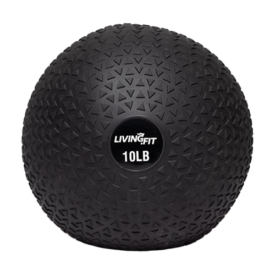
Living.Fit slam balls are made to use every day without fail. The dense rubber shell is filled with sand to prevent rolling and bouncing while the textured outer layer gives a solid grip even when sweating during rigorous workouts. They’re available in weights from five pounds to 100 pounds with diameters from nine inches to 13 inches.
Living.Fit Slam Ball Video Review
Our reviews writer, Jake, puts the Living.Fit slam ball to the ultimate test during his detailed video review. Follow along as he tells you everything you need to know about this product, and whether or not you should add one to your home gym.
Living.Fit Slam Ball Highlights
When we put these slam balls from Living.Fit to the test, we enjoyed the durability and functionality they offer. We went through an entire session of tossing these around like a rag doll, and felt they were strong enough to handle the most grueling workouts due to the durable rubber exterior. The textured surface was extremely helpful since it allowed us to maintain a solid grip as we began to sweat. Sometimes slam balls with a sand filling can feel lopsided as you’re working out, but we didn’t experience that during the time we had with ours.
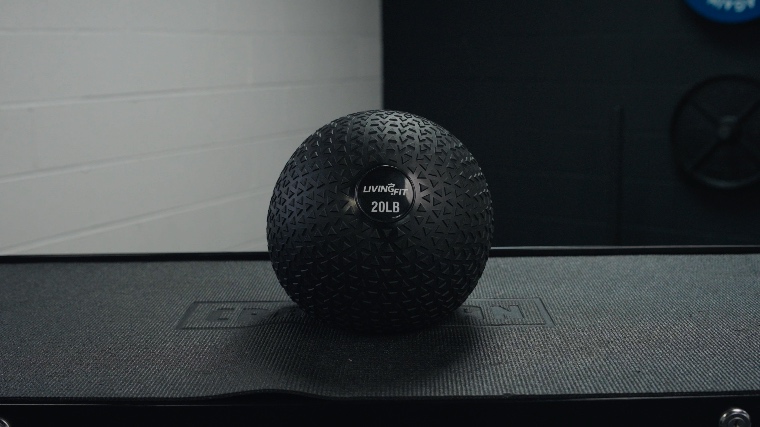
Unlike some other slam balls on the market, Living.Fit designed their slam balls to absorb impact and not bounce off surfaces (whether it be the ground or a wall). Some people may not enjoy that since it eliminates rotational throws almost entirely, but we didn’t find it to have a negative impact on our workouts. These slam balls are also some of the more expensive options available, but we think the price tag is worth it due to the high-quality textured surface and the slew of weight options that range from five pounds up to 100 pounds.
Who Should Buy A Living.Fit Slam Ball
- Anyone looking for a slam ball with a good grip will enjoy the textured rubber surface when they begin to sweat.
- Since there are 20 weight options available, almost everyone can find one that matches their strength level.
- Folks looking for a sand-filled slam ball that doesn’t bounce should strongly consider these.
Who Shouldn’t Buy A Living.Fit Slam Ball
- Athletes who prefer a gel-filled slam ball may not be crazy about the sand-filling featured here.
- Texture is a personal preference, so some people may prefer a slam ball that has a smoother surface than these do.
- Anyone who is working with a tight budget may want to check out some cheaper options.
Price
When browsing the numerous weights Living.Fit offers for their slam balls, you’ll find they have a wider range of options than much of their competition. The cheapest option is the five-pound ball, and it’s going to run you around $30, the 20-pound ball is about $55, the 50-pounder is around $90, and the 100-pound option is nearly $150. While some companies can charge around $20 more for their slam balls, these ones certainly aren’t cheap.
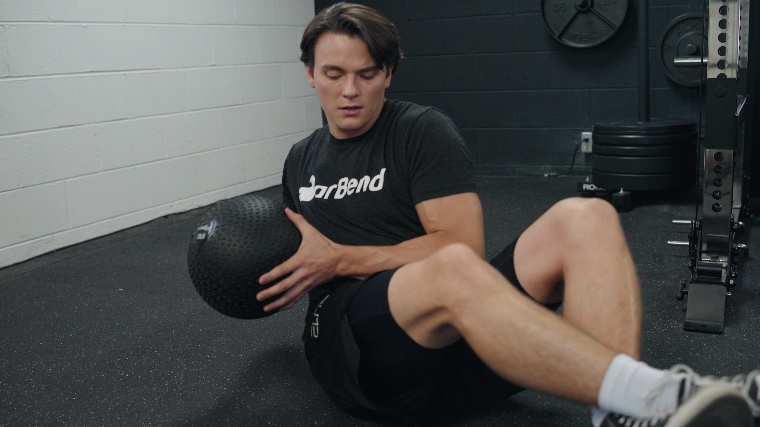
If you’re on a tight budget, you might want to consider some of the cheaper options out there. However, those cheaper slam balls are cheaper for a reason, and likely won’t last you nearly as long as these will. In the long run, we think the price of these Living.Fit slam balls is valid due to their durability.
Overall Build and Quality
Living.Fit designed their slam balls with a durable rubber coating that has a really solid textured grip. This triangular pattern grip is going to come in handy as you begin to sweat during your workouts and ensures that the ball will not slip out of your hands. These slam balls are designed to absorb the impact when you throw them at a surface, which means they won’t bounce back at you. While some people may be hesitant to purchase a sand-filled slam ball, we didn’t feel as if the weight distribution was off-balance during our workouts. We think these slam balls are pretty durable and should last you for around five years, as long as you treat them with care.
Features
There were quite a few features we enjoyed when we tested the Living.Fit slam ball. Finding the right texture for your equipment is a big deal, and we think the triangular-patterned textured surface of these slam balls is about as good as it gets for your grip. The sand filling in these slam balls leads to a dead bounce, which makes them ideal for heaving them into the ground — but less than ideal for rotational throws into a wall.
Textured Grip
Similar to how the grip on barbells and dumbbells varies from company to company, the surface of a slam ball also varies. Some companies feature a relatively smooth surface with a few raised lines — Living.Fit designed their slam balls with a textured surface similar to treads on a tire.
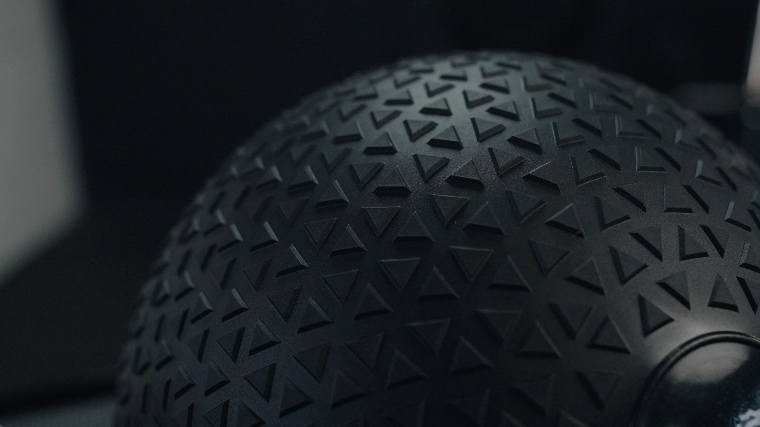
The triangular pattern provides a sound grip even when the sweat hits. We found this to be really helpful since we never felt as though our grip was compromised during a throw.
Filling
Not only does the surface of a slam ball tend to vary, but so does the filling. Some slam balls feature a gel-filled interior, which tends to feel similar to a medicine ball. However, these slam balls are filled with sand, which results in a dead bounce. This is ideal for doing ball slams into your floor, as you won’t have to worry about the ball coming back up and smacking you square in the face. However, this sand filling/dead bounce won’t work for athletes who enjoy doing rotational throws on a wall, as this ball won’t bounce back to you.
Color
These Living.Fit slam balls are black in color, and feature white lettering on the front that resembles a Magic 8 Ball.
Product Specs
Living.Fit implements a highly durable rubber coating for their sand-filled slam balls. There are a lot of buying options to choose from since these slam balls range from five pounds to 100 pounds, and the diameter of each option is influenced by the slam ball’s weight.
Materials
These slam balls from Living.Fit feature a durable, textured rubber exterior that should last the avid slam baller around five years, and maybe even longer for those who only perform slam ball workouts on occasion.
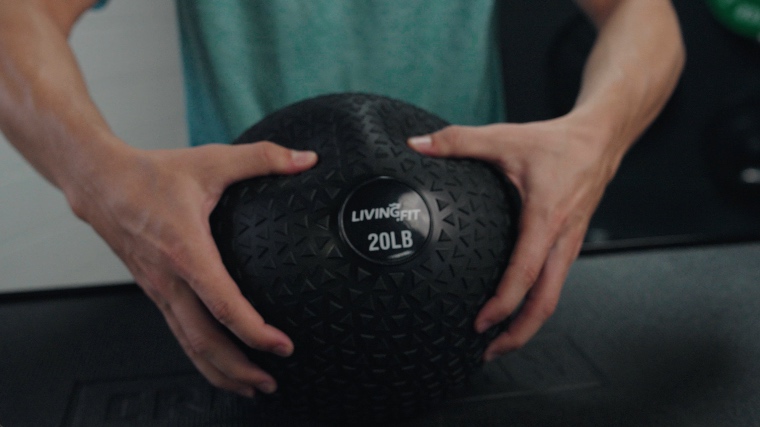
The sand-filled interior felt balanced in our hands while working out, so we don’t think you’ll have to worry about the weight distribution varying during your throws.
Slam Ball Type
These are slam balls and not medicine balls. Medicine balls tend to have some bounce in them, while these certainly do not. Though you can still perform some of the same exercises with them as you would medicine balls — such as Russian twists for your core or alternating lunges — you’ll need to look elsewhere if you’re wanting a ball that will bounce back at you.
Weight Options and Dimensions
Living.Fit offers these slam balls in a wide range of weight options — from five pounds all the way up to 100 pounds. Another thing worth mentioning is that the overall size of each slam ball is a direct correlation to the actual weight.
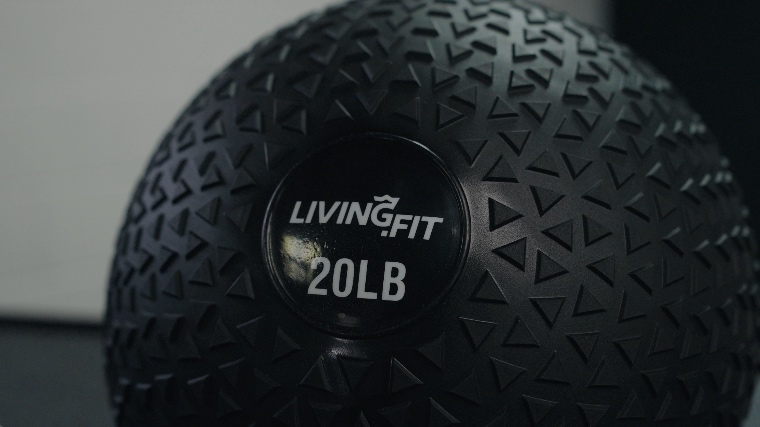
For example, the five to 20-pound options have a nine-inch diameter, the 25 to 60-pound balls feature an 11-inch diameter, and the 70 to 100-pound options have a 13-inch diameter. So if you’re someone who wants to learn how to carry an Atlas stone, this could be a good way for you to practice safely. However, if you’re someone of elite strength and are already an Atlas stone expert, you’ll likely need to search elsewhere for a heavier slam ball.
Warranties
Living.Fit offers a two-year warranty for at-home usage for these slam balls, and a one-year warranty for commercial usage.
Places to Buy
You can purchase your Living.Fit slam ball directly through Living.Fit’s website or Amazon.
Company Information
Since 2018, Living.Fit has been focused on making fitness as simple as possible for athletes of all levels. If you want to inquire about their operations, you can send an email to info@living.fit, and a representative from their team will answer any questions you may have.
Final Word
Slam balls can be an extremely beneficial tool when it comes to functional training. They can be used for quick cardio sessions, core work, building strength, and of course, a good release for any frustrations you may have. These slam balls from Living.Fit are high-quality, and feature a sand filling with a textured rubber coating that offers a solid grip.
With weights ranging from five to 100 pounds, we think the majority of athletes should be able to find a suitable option here for their fitness level. While these may be on the expensive side of the market, we think the durability here makes them worth their cost. If you’re looking to add a solid slam ball to your home gym, Living.Fit has you covered.
FAQs
How much does a Living.Fit Slam Ball cost?
Since Living.Fit offers various slam balls that range from five to 100 pounds, the prices also vary. The cheapest option is the five-pound ball, which sports a price tag of about $30. The 20-pound ball we tested is priced at about $55, the 50-pounder will run you around $90, and the 100-pound option is roughly $130. There are a good number of cheaper options out there, but we think the high quality of these slam balls is worthy of the price tag.
What purpose does the sand fill in the Living.Fit slam balls serve?
The sand filling found in these slam balls leads to a dead bounce. This isn’t ideal for rotational throws, but it does come in handy when performing ball slams since you won’t need to worry about the ball bouncing back at you in the face.
What workouts can I use a Living.Fit Slam Ball for?
The awesome thing about slam balls is that they can be used for a wide variety of workouts. You can easily use them to target your core; you can incorporate them into walking lunges, do a shoulder throw, have them replace an Atlas stone, and use them for overhead carries.
How many weight options does Living.Fit offer with their slam balls?
These slam balls feature weights as light as five pounds and as heavy as 100 pounds. While some powerlifters may need a heavier weight, we still think this is a solid range for most athletes.